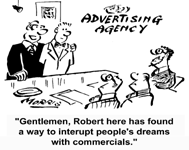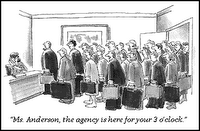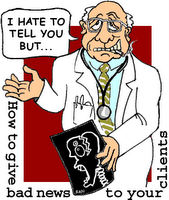Pemasaran
Isn't it good if your customers pay on time?
 The best Christmas present for my company this season is the collection of a big amount of money from various projects which had been owed to us for quite some time. Some of these overdue have been more than 90 days. While the collection of this money has been a big cash present for us; there are still a couple of bad debts which had yet to be recovered.
The best Christmas present for my company this season is the collection of a big amount of money from various projects which had been owed to us for quite some time. Some of these overdue have been more than 90 days. While the collection of this money has been a big cash present for us; there are still a couple of bad debts which had yet to be recovered.As stated by the Australian credit management, there are typically 3 reasons why customers don’t pay.
• The customer can’t pay
• The debt is disputed
• The customer had no intention of paying
When you have customers like them, it will affect your cash flow and as we all know, cash flow is king. So what steps can you take to speed up the collection of your money and not to have bad paying customers?
1. First rule: Get payment first before you deliver. Get at least a portion or 50% up front before you start work.
2. Send out invoices/bills on time. The earlier you send it out, the sooner you can collect your money.
3. Monitor payments/receivables daily. Keep a close eye of this everyday; make sure you know which payments are overdue.
4. As soon as the invoices are overdue (our term is Net 7, which means it is overdue after 7 days), immediately send out reminders. The longer the invoice is not paid, the harder it is to get your money.
5. Call your customers or their accounts department to chase up the payment. The faster you get your money, the better your cash flow.
6. Extend customer payment if they can’t pay but you need them to commit to a formal payment plan.
7. As soon as you have identified a bad customer, stop sales to them and stop servicing them until they have paid or at least make a commitment to pay.
8. Get the professionals to collect your money. When it is way overdue and the customer is not paying, it is time to hire a debt collection agency.
Now I hope this will help you and myself to be better in collecting our money. Merry Christmas and Happy New Year everyone.
Saturday, December 09, 2006
Google Click-to-Call
 My company recently tried out Google's new Click-to-Call advertising program and it turned out both a comedy and a disappointment.
My company recently tried out Google's new Click-to-Call advertising program and it turned out both a comedy and a disappointment.3 phone calls were made at a cost of $81.46. This is almost $27 per phone call, bloody expensive! Well, hmm not really if the calls were actually sales leads. Now comes the funny part.
One of the calls was made by a guy who called just for fun. It's the first time he saw a click-to-call ad and keyed his number on our ad just to see how it works.
The second was made from Pizza Hut asking if we want to order a pizza!
Finally, the third call went missing in action. God knows, where the call went.
Sunday, November 26, 2006
Advertising Frequency: How many times is it effective?
 So how many times does a consumer need to see your advertisements before he/she will remember, respond and then buy from you? Marketers call this effective advertising frequency.
So how many times does a consumer need to see your advertisements before he/she will remember, respond and then buy from you? Marketers call this effective advertising frequency.Well, it really varies depending on whether it is push or pull advertising.
Push advertising - most traditional offline advertising such as magazine, newspaper, TV as well as online banner ads and emails are push marketing.
Pull advertising - Examples are search engine advertising (Google adwords, Yahoo search marketing), directory listings, yellow page ads etc.
I would say push advertising will take many more times than pull advertising to take effect.
Some says around 3 to 5 times; others say the magic 7; while Thomas Smith, a nineteenth century London businessman (1885) says it is the 20th time.
The first of many is known as the 3+ frequency. Research has shown that consumers need to see an advertisement around 3 plus times before it becomes effective (can recall product and brand).
The second is known as the seven times factor. A cardinal rule of thumb in advertising is: potential customers usually need to see the name of a product seven times or more before they're motivated enough to even think about making a purchase.
Finally, Thomas Smith says that it can take up to 20 times!!
The first time people look at any given ad, they don't even see it.
The second time, they don't notice it.
The third time, they are aware that it is there.
The fourth time, they have a fleeting sense that they've seen it somewhere before.
The fifth time, they actually read the ad.
The sixth time they thumb their nose at it.
The seventh time, they start to get a little irritated with it.
The eight time, they start to think, "Here's that counfounded ad again."
The ninth time, they start to wonder if they're missing out on something.
The tenth time, they ask their friends and neighbors if they've tried it.
The eleventh time, they wonder how the company is paying for all these ads.
The twelfth time, they start to think that it must be a good product.
The thirteenth time, they start to feel the product has value.
The fourteenth time, they start to remember wanting a product exactly like this for a long time.
The fifteenth time, they start to year for it because they can't afford to buy it.
The sixteenth time, they accept the fact that they will buy it sometime in the future.
The seventeenth time, they make a note to buy the product.
The eighteenth time, they curse their poverty for not allowing them to buy this terrific product.
The nineteenth time, they count their money very carefully.
The twentieth time prospects see the ad, they buy what is offering.
With all this research and theory shown, does that mean that people will automatically buy your product if they see your ad 3, 7 or the 20th time? Well not really, if you ad is not relevant to what they need, want or searching for. Even if they see your ad a thousand times, they will still not buy a damn thing from you. However, it is still important to know the more places your ad is available to be seen, the greater your chance at making that sale.
Now question time, do you know what is your effective advertising frequency? On average, how many times does your customer see your ads before they buy from you? This is a tough question especially you are advertising offline. However, in the online environment, your web analytics should be able to give you these stats.
Sunday, November 19, 2006
Strategy & Tactics: Sun Tzu 孫子??
 'Strategy without tactics is the slowest route to victory. Tactics without strategy is the noise before defeat'. In other words, planning without action is futile, action without planning is fatal.
'Strategy without tactics is the slowest route to victory. Tactics without strategy is the noise before defeat'. In other words, planning without action is futile, action without planning is fatal.Many people in the west believe that this quote is made famous by the great Chinese general Sun Tzu 孫子. However, when I did a search on the web, there were a number of discussions that this quote is not by Sun Tzu. Neither could I find this quote on the Chinese version of the Art of War 孫子兵法.
Now, this really puzzles me. So who exactly wrote this quote?
Saturday, October 21, 2006
The people factor
 In 1997, Steve Jobs, the founder and former CEO of Apple Computer, returned to the company to help revive the ailing personal computer market. One of the first calls he made was to Lee Clow, TBWA/Chiat/Day's legendary chairman and chief creative officer worldwide. Apple was considering a number of agencies at the time, but Jobs cut short the review process and awarded the business to TBWA/Chiat/Day, noting "I don't pick advertising agencies; I pick people."
In 1997, Steve Jobs, the founder and former CEO of Apple Computer, returned to the company to help revive the ailing personal computer market. One of the first calls he made was to Lee Clow, TBWA/Chiat/Day's legendary chairman and chief creative officer worldwide. Apple was considering a number of agencies at the time, but Jobs cut short the review process and awarded the business to TBWA/Chiat/Day, noting "I don't pick advertising agencies; I pick people."People are the ones that make up the company. It is people that we deal with in and out each day. When you are marketing or selling to a business, you are actually dealing with its people. It is not about my company and your company. It is about me and you. Most importantly, develop a relationship and make them like you.
It is also important in your business that you emphasise this people factor. Build your people up and build your business around them whenever possible, make them a big part of your business. At the end of the day, it is them that are doing the marketing and selling not your brand!
Sunday, July 02, 2006
The condom theory
 Everyone wants to feel that they are important. This is the reason why you have different service/product plan such as silver, gold and platinum or deluxe and premium. There are rarely basic or starter plans nowadays. Customers want to buy or belong to a plan that is of high value and status.
Everyone wants to feel that they are important. This is the reason why you have different service/product plan such as silver, gold and platinum or deluxe and premium. There are rarely basic or starter plans nowadays. Customers want to buy or belong to a plan that is of high value and status.This is the same as what I call the condom theory. Almost all condoms nowadays come in the size of big, large, extra large. Which man wants to buy a small size condom and admit that their penis is small!?
The thing here is even if you are offering a really basic service; named it well where your customers will feel that they are important and of value.
Monday, June 12, 2006
Firing Your Clients
 Recently, I had a client whom I had a number of times would like to say to him: "Sorry S...., I would like to stop doing business with you!" This is a client who constantly raise his voice at you and calls you every 30 mins. Calls you on the weekend and always says the big Fxxx & Bullshit words. In fact, he is happy with our service but because he is such an inconsiderate and a rude man; it makes it so difficult to do business with him. This is one client whom I think deserves to be on a 'firing' list. Here are 11 more that you and I if we come across should definitely fire:
Recently, I had a client whom I had a number of times would like to say to him: "Sorry S...., I would like to stop doing business with you!" This is a client who constantly raise his voice at you and calls you every 30 mins. Calls you on the weekend and always says the big Fxxx & Bullshit words. In fact, he is happy with our service but because he is such an inconsiderate and a rude man; it makes it so difficult to do business with him. This is one client whom I think deserves to be on a 'firing' list. Here are 11 more that you and I if we come across should definitely fire:- THE DISILLUSIONED consistently expresses disappointment with your work even though it is of good quality and conforms to spec. A client who is constitutionally incapable of appreciating your work is not a client you should be involved with.
- THE SUSPICIOUS consistently expresses a lack of trust, disdain for your work, or questions your integrity. A client who is constitutionally incapable of trusting in your expertise is not a client you should be involved with.
- THE CHISELER consistently complains about your bill, even though it conforms to the estimate they agreed to. A client who is constitutionally incapable of honoring a deal is not a client you should be involved with.
- THE BULLY consistently is verbally abusive or threatening to you.
- THE SOMETHING-FOR-NOTHING consistently increases the scope of the project but refuses to pay for the additional work. A client who is constitutionally incapable of offering additional value in exchange for additional value is not a client you should be involved with.
- THE SLOW PAY consistently pays invoices late. In any business, cash flow is king. A client who is constitutionally incapable of paying a bill on time for work that was delivered on time is not a client you should be involved with.
- THE FLAKE consistently is late meeting responsibilities, but still holds you to the original schedule. A client who is constitutionally incapable of understanding that in order for a project to be delivered on-time, everyone must meet their obligations is not a client you should be involved with.
- THE LIAR consistently lies to you. A client who is constitutionally incapable of being honest with you is not a client you should be involved with
- THE CLINGER consistently makes unreasonable demands regarding your availability. A client who is constitutionally incapable of applying a "reasonable man" standard to requests for your time is not a client you should be involved with.
- THE BLACKMAILER consistently refuses to pay an invoice until you perform additional work at no charge. A client who is constitutionally incapable of engaging in good-faith dealings is not a client you should be involved with.
- THE MONEY PIT consistently is unprofitable. A client who is constitutionally incapable of offering you a fair rate for your services is not a client you should be involved with.

No comments:
Post a Comment